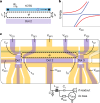Interferometric single-shot parity measurement in InAs-Al hybrid devices
- PMID: 39972225
- PMCID: PMC11839464
- DOI: 10.1038/s41586-024-08445-2
Interferometric single-shot parity measurement in InAs-Al hybrid devices
Abstract
The fusion of non-Abelian anyons is a fundamental operation in measurement-only topological quantum computation1. In one-dimensional topological superconductors (1DTSs)2-4, fusion amounts to a determination of the shared fermion parity of Majorana zero modes (MZMs). Here we introduce a device architecture5 that is compatible with future tests of fusion rules. We implement a single-shot interferometric measurement of fermion parity6-11 in indium arsenide-aluminium heterostructures with a gate-defined superconducting nanowire12-14. The interferometer is formed by tunnel-coupling the proximitized nanowire to quantum dots. The nanowire causes a state-dependent shift of the quantum capacitance of these quantum dots of up to 1 fF. Our quantum-capacitance measurements show flux h/2e-periodic bimodality with a signal-to-noise ratio (SNR) of 1 in 3.6 μs at optimal flux values. From the time traces of the quantum-capacitance measurements, we extract a dwell time in the two associated states that is longer than 1 ms at in-plane magnetic fields of approximately 2 T. We discuss the interpretation of our measurements in terms of both topologically trivial and non-trivial origins. The large capacitance shift and long poisoning time enable a parity measurement with an assignment error probability of 1%.
© 2025. The Author(s).
Conflict of interest statement
Competing interests: The authors declare no competing interests.
Figures




References
-
- Bonderson, P., Freedman, M. & Nayak, C. Measurement-only topological quantum computation. Phys. Rev. Lett.101, 010501 (2008). - PubMed
-
- Kitaev, A. Y. Unpaired Majorana fermions in quantum wires. Phys.-Usp.44, 131 (2001).
-
- Lutchyn, R. M., Sau, J. D. & Das Sarma, S. Majorana fermions and a topological phase transition in semiconductor-superconductor heterostructures. Phys. Rev. Lett.105, 077001 (2010). - PubMed
-
- Oreg, Y., Refael, G. & von Oppen, F. Helical liquids and Majorana bound states in quantum wires. Phys. Rev. Lett.105, 177002 (2010). - PubMed
-
- Karzig, T. et al. Scalable designs for quasiparticle-poisoning-protected topological quantum computation with Majorana zero modes. Phys. Rev. B95, 235305 (2017).
LinkOut - more resources
Full Text Sources

